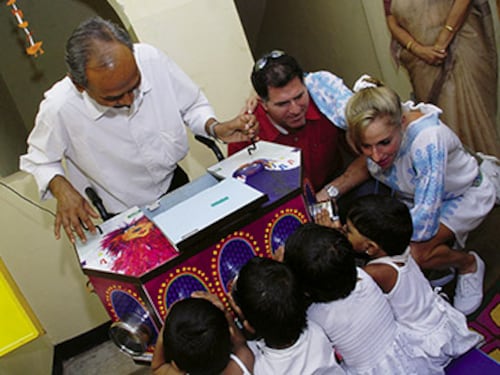The Dell Foundation and its Queen Susan
Susan Dell brings passion, energy, and focus to her $900 million foundation that helps children
Prefer us on Google

“The Dell Scholars make me cry,” says Susan Dell. She’s referring to a note she received last week from a student in the college programme funded by the Michael & Susan Dell Foundation, the Austin, Texas, charity devoted to improving the lives of poor urban children. “When I get a letter that tells me I changed this person’s life, well, that resonates more than anything.”
Don’t mistake the tears for weakness or her golden-girl good looks and irrepressible energy for frivolity. Her husband, Michael—the 41st-richest person on the planet, with a net worth of $15.9 billion, according to the 2012 Forbes Billionaires list—usually soaks up the headlines. But Susan, 48, is a fully vested partner in their nearly $1 billion foundation.
“Michael and Susan are both really focussed, really intense people,” says Dell Foundation executive director Janet Mountain. “They both have the ability to really home in on an idea and engage you with it. The difference is Michael comes at problems from the systems side, while Susan feels a real connection with people.” When the Dells were drafting the Scholars programme, for example, Michael wanted to be sure the students were steeled for academic success and required that they be part of an approved college-readiness programme. Susan’s concern was more personal, which resulted in laptops, family crisis support, and an online community for the Scholars.
The Dells were longtime philanthropists in the Austin area before they started the Dell Foundation in 1999. Their name appears on medical, science, art, Jewish, and youth centres across the region. “But we really didn’t have a focus,” Susan says. “Our giving was more about what felt important at the time or when people made requests. That’s when we decided our giving was bigger than the two of us.”
By then, the Dells had four children: Kira, now 20 Alexa, 18 and twins Zachary and Juliette, 15. Susan became convinced that the focus of her home should be the blueprint for the Dell Foundation’s mission: Kids and families. But the children she latched on to are the ones for whom school, diet, exercise, and durable family life are often danger zones. “What was important was taking care of children who weren’t as fortunate as our own or as we were when we were kids,” she says.
But how to choose among the 16 million children in the US living in poverty, to say nothing of the 1 billion worldwide? “There’s a lot of need out there,” Dell says. “So we have to stay disciplined and focussed on our mission and our goals.” Namely, concentrating on health, education, and economic stability within families.
Her focus begins with wellness. Susan does not start the morning without exercise, a seven-day-a-week commitment to biking, hiking, and charity walks. “She’s out there on the trail, sweating with all of us, leading by example,” says Austin mayor Lee Leffingwell. Like Michael, Susan has the entrepreneurial gene (she opened her first clothing line in 1997 and closed her final collection, PHI, in 2010), and she brings a spirit of ownership to the Dell Foundation. She’s not chained to her desk and mostly takes advantage of the virtual office: Staying in constant contact with programme officers and logging into a special software system that allows real-time snapshots of foundation business.
The foundation reflects her concerns as a mother, down to the worries of kids eating right and doing well in school. “Her vision was based on her struggles in making sure that her kids had healthy options in terms of health messages and in school and the community,” says Ginny Ehrlich, CEO of Alliance for a Healthier Generation, an organisation funded by the Dell Foundation. “Her thought was, If I need to help my kids navigate all these environments, how do moms do it who might not have the economic advantages that I do?”
The Dell Foundation started with projects close to home, including classroom coaching initiatives, school-break activities, Marathon Kids, and the Dell Children’s Medical Center of Central Texas. The next step was to address children in urban areas across the country. Its dollars now flow into public and charter schools in New York City, Baltimore, and Oakland, California into health initiatives such as Ehrlich’s child-obesity-fighting organisation and into nationally focussed name brands like Teach for America, Livestrong, and the Dell Scholars Program.
More recently, the Dells started funding microfinance and water-sanitation services in India and programmes for orphans and vulnerable children in South Africa. What started with 5.4 million shares of Dell stock, valued at $282 million, has grown to a $906 million endowment and $100 million in commitments to 150 projects. It is the 53rd-largest US foundation in terms of total giving, and number 68 in asset size, according to the Foundation Center.
The Dells are members of a swelling crowd of billionaire philanthropists. “If you’re an entrepreneur, you feel a sense of indebtedness to the community or places around the world where you do business, which have helped you get where you are,” says Jeff Clarke, interim president and CEO of the Council on Foundations. Dell bristles at the characterisation of her work as a species of payback. “I don’t look at it as an obligation,” she says. “We surely don’t need to have more money than necessary to take care of our family, so why wouldn’t we give?”
Dell still seems surprised when she’s mentioned in the same philanthropic conversations as Bill and Melinda Gates. “When I’m sitting in a room with President Clinton and talking about things we’re partnering with, I feel like, ‘Wow, I’m really doing something pretty big here.’”
First Published: Nov 27, 2012, 06:01
Subscribe Now